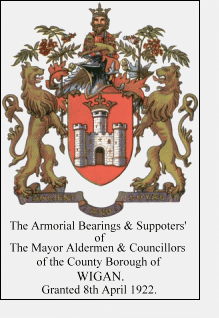|

 
Excerpts from an Article, by Mr. Arthur J. Hawkes, Chief Librarian. POSSESSING a series of town seals from the twelfth century onwards, Wigan, at the opening of the twentieth century still remained without "ensigns proper to its order."
WIGAN is not only the oldest borough in Lancashire, it is one of the oldest in England - certainly among the first ten. Town liberties or borough rights existed in England in Anglo-Saxon times, several centuries before the Norman Conquest. Places like London, York, Winchester, Norwich, etc., are known from records to have exercised these privileges, and it may properly be inferred that Wigan also enjoyed them. Finally we have the report of the Norry King of Arms in 1613 that "the towne and bourrough of Wiggin was antiently Incorporated by the most noble Kinge, Kinge Hen, the first in the first yeare of his raygne" (i.e., 1100) - a certified copy of which document is now in the Public Library. Under William the Conqueror, the borough privileges were restricted, but on the accession of Henry I they were largely restored by virtue of his great coronation charter of liberties. The liberties of individual towns were restored or confirmed by special charter, some of which are extant. If we can rely upon the report of the Herald in 1613, Wigan was one of the very first boroughs to be so restored. Following this we have a long series of royal charters, mostly still extant, some containing special marks of royal favour, which charters will be detailed in the next number.
MR. J. Paul Rylands describes the coat above as "perhaps the very best of all Lancashire town arms, for it might, heraldically, belong to the Middle Ages, and is indeed symbolic of antiquity and loyalty." It is certainly a very privileged coat of arms, as few if any coats bear so many symbols of royal favour. - indeed, the incorporation of royal insignia into armorial bearings is jealously guarded and usually proscribed by the court officials. In Wigan's new grant there are (1) A King's Head, crowned, (2) the Royal "Leopard" (or "lion couchant guardant"), (3) a Mediaeval royal crown, and (4) the Supporting Lions. The King's head in the crest officially represents no particular king, in the words of the Rouge Croix herald (in whose hands the design took shape) it is intended "to be a conventional likeness to an early English Monarch." It is actually modelled on the portrait of King Edward III., but from the point of view of the town it symbolizes especially King Henry I. On Wigan's earliest town seal - probably the twelfth century - there appears to be a towered or castellated gateway over the centre of which is depicted what seems to be the crowned head of Henry I. These devices therefore, are taken as the chief symbols of the new bearings, the towered gateway becomes a Norman castle and the King's head becomes a crest - indicating Wigan as a town of consequence and royal patronage at the opening of the twelfth century. The royal lion, again, marks another important period in Wigan history. Edward III., by a charter of 1350, granted Wigan the right (with several other towns) to use a royal seal known as the "King's Recognisance Seal," on which was figured the King's head and the royal lion. The Somerset Herald expressed the opinion that as none of the other towns had made use of the King's permission by adopting the figures in their arms, Wigan could with propriety include them, and his view prevailed with the Chapter of Heralds.
SUPPORTERS are nowadays usually granted only to the great cities, but Wigan's ancient importance has been thereby recognised, the lions giving the distinction to a highy dignified and privileged coat of arms. There is a final feature of unusual interest. The branches of the mountain ash held in the lion's paws add something to the conventional "mantling" or flowered scrolls which usually ornament armorial bearings. The design of the floriation is usually a matter for the artist and without heraldic significance. But in the case of Wigan's arms, the mountain ash, known in the northern dialects as the Wiggin or Wigan Tree, forms a "rebus" or pun on the name of the town, and has the advantage of giving further symbolism to an already significant coat. The rebus has tradition behind it, for the Wiggin Tree is a conspicuous feature of several of the town's mediaeval seals.
The motto adopted "Ancient and Loyal" is in keeping with the arms. For a great many years Wigan has on all occasions, official and unofficial, invariably referred to itself as the "Ancient and Loyal Borough," but few are aware that authority for its use can be found in the Charter of Charles II. - the governing charter of the town down to the Municipal Corporations Act of 1835. In that Charter Wigan is designated by the King "an ancient borough" and granted a "special token of our favour for its loyalty to us," so that nothing could be more fitting than its adoption as the town's motto.
|
|